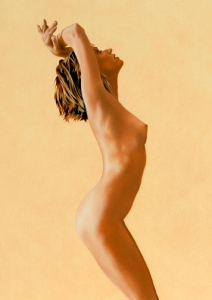Today’s Technique Tuesday post is going to take a look at an aspect of art creation that many art appreciators easily forget–the surface under the paint!
Here we have pictured just a few examples of the many different types of surfaces fine artists use to create their artwork. These are several of the most common–canvas, wood, masonite, paper, copper, aluminum, vellum–but there is truly an astounding variety out there when it comes to different artists’ preferred surfaces. They can all be divided into two basic categories: rigid (wood, panel, metal) and flexible (canvas, paper, vellum) materials.
Many different factors go into the choice an artist makes for what surface they wish to paint on. The type of paint, the aesthetics of the surface texture, the absorbency of the material, the “tooth” (the amount of surface texture), the stability, the longevity, and even the light permeability of a material may all play a part in the decision.
Early on in the history of art, the most commonly used surfaces for painting were rigid surfaces like stone and most especially, wood. Wood made for an especially good surface to paint on during the Middle Ages in Europe, when paintings were often created to be used as altarpieces, and wood could be fashioned into a nice multi-panel altarpiece, sometimes with hinges to allow it to open and close, as in the center example here:

(left to right) Boy from Al-Fayum, 2nd century encaustic painting on wood; “Ghent Altarpiece” 1432 painting on 12 wood panels by Jan Van Eyck; “Mona Lisa,” 1503-1506 oil on poplar panel by Leonardo da Vinci
Many factors played a part in the popularization of canvas toward the latter years of the Renaissance. The fact that canvas was lighter, more portable, relatively affordable, and stood up better than wood to time and damp environments all quickly made it a very popular choice among artists for centuries to come. It became a particularly handy material due to its portability by the time plein air painting (painting on location outdoors) became popular in the 19th century. Here’s an example, from Impressionist painter Claude Monet:
There are many varieties of canvas used today, such as hemp, cotton, linen, and flax, and within these categories are also varying degrees of quality, stiffness, and tooth. If you ask ten different artists what their favorite type of canvas is, you might very well get ten different answers! Personal preference plays a large role in the choice of canvas, but as with most painting surfaces, the most important aspect is to prime the surface well (usually with a gesso-type material).
While wood panels and stretched canvas are the two most commonly seen surfaces used for painting throughout art history, there have also been many other materials experimented with, many of which are becoming more and more popular with today’s artists, who have a wide variety to choose from.

(left to right) Rembrandt van Rijn, “Self Portrait,” oil on copper, 1630; Andre Derain, “Maurice de Vlaminck,” oil on cardboard, 1906; Joan Miro, “Painting,” oil on masonite, 1936
These “other” surfaces range from metals like copper and aluminum, to pressed boards like cardboard and masonite, to more obscure surfaces like glass and plastic. Each surface has its pros and cons, both in regards to how it “takes” the paint as well as how it stands the test of time, but once again it all really comes down to the personal preferences of the artist, and you’ll find excellent pieces of artwork created on all kinds of surfaces.
The International Guild of Realism 10th Annual Juried Exhibition, currently hanging here at the gallery, features 91 paintings and drawings by 81 different artists, and it’s a really great example of the variety of materials and surfaces that fine artists use to create their incredible artworks. Here are a few great examples from the show illustrating the variety of surfaces included, but if you haven’t seen the whole show yet, be sure to check it out, either at the gallery on on our website here!










